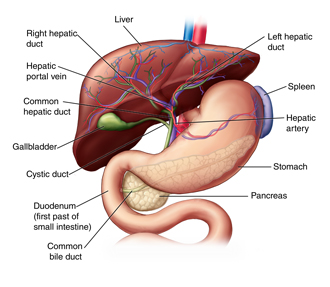Liver: Anatomy and Functions
The Liver: Anatomy and Functions
Anatomy of the liver
The liver is an organ in the upper right-hand part of your abdomen. It sits under the diaphragm, and on top of the stomach, right kidney, and intestines.
The liver is a dark reddish-brown color, and is shaped a bit like a wedge. It weighs about 3 pounds. The liver has 2 lobes. Both are made up of 8 segments that have of 1,000 small lobes called lobules. These lobules are connected to small tubes (ducts) that lead to larger ducts that form the common hepatic duct. The common hepatic duct sends the bile made by the liver cells to the gallbladder and the first part of the small intestine (duodenum) through the common bile duct.
The liver holds about 1 pint (13%) of your body's blood supply. There are 2 blood vessels that send blood to the liver. They are:
- Hepatic artery. This sends oxygen-rich blood to the liver.
- Hepatic portal vein. This sends nutrient-rich blood to the liver.
Functions of the liver
The liver has more than 500 vital functions. All the blood leaving the stomach and intestines passes through the liver. The liver processes this blood. It breaks down, balances, and creates nutrients. It also processes medicines and other chemicals. The liver:
-
Makes bile, which helps carry away waste and break down fats in the small intestine during digestion
-
Makes certain proteins for blood plasma
-
Makes cholesterol and proteins to help carry fats through the body
-
Converts excess glucose into glycogen for storage and makes glucose as needed
-
Controls blood levels of amino acids, which are the building blocks of proteins
-
Processes hemoglobin for its iron and then stores the iron
-
Converts ammonia to urea, which is then excreted in urine
-
Clears medicines, drugs and other substances from the blood
-
Controls blood clotting
-
Helps prevent infections by making immune factors and removing bacteria from the blood
-
Clears bilirubin from the blood
When the liver has broken down harmful substances, this waste is excreted into the bile or blood. Waste in bile enters the intestine and leaves the body in the form of feces. Waste in blood is filtered out by the kidneys, and leaves the body in the form of urine.
Updated:
May 03, 2019
Sources:
Hormonal Regulation of Hepatic Glucose Production in Health and Disease. Lin H. Cell Metabolism. 2011;14(1):s9-19., Normal Liver Anatomy. Sibulesky L. Clinical Liver Disease. 2013;2(s1)s1-3.
Reviewed By:
Jen Lehrer MD,Ronald Karlin MD,L Renee Watson MSN RN
